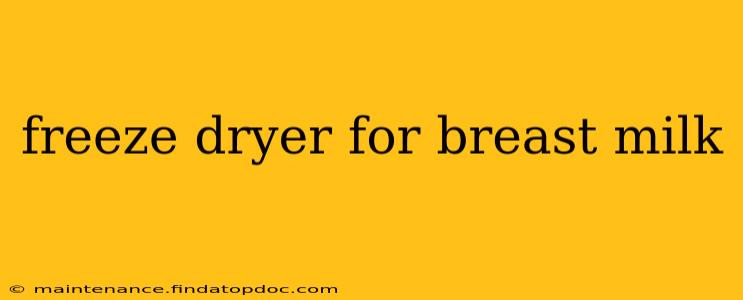Breastfeeding mothers often face the challenge of milk oversupply or the need to store milk for later use. Freeze drying offers a compelling alternative to traditional freezing, promising longer shelf life and potentially superior nutrient retention. However, using a freeze dryer for breast milk requires careful consideration and understanding. This comprehensive guide explores the feasibility, benefits, and drawbacks of using a freeze dryer for preserving breast milk.
Is it Safe to Freeze Dry Breast Milk?
This is a crucial question, and the short answer is: it's not definitively proven safe and is generally not recommended. While freeze drying preserves food effectively, the process's impact on the delicate components of breast milk needs further robust scientific study. The potential risks associated with altered protein structures and nutrient degradation necessitate caution. Current guidelines overwhelmingly recommend freezing as the primary storage method for breast milk.
What are the Potential Benefits of Freeze Drying Breast Milk?
While the safety and efficacy require further research, potential benefits of freeze drying breast milk, compared to traditional freezing, are theoretically:
- Longer shelf life: Freeze drying removes almost all water, significantly reducing the risk of bacterial growth and enzymatic degradation, potentially extending the shelf life.
- Reduced freezer burn: Freeze drying eliminates ice crystal formation, which is a common cause of freezer burn that degrades the quality and flavor of breast milk.
- Easier transport: Freeze-dried breast milk would be lighter and easier to transport, potentially beneficial for mothers who need to travel or for humanitarian aid situations.
- Potential for improved nutrient retention: While not confirmed, some research suggests that freeze drying may retain certain nutrients better than traditional freezing methods.
What are the Potential Drawbacks of Freeze Drying Breast Milk?
The major drawbacks currently outweigh the potential benefits:
- Cost: Freeze dryers are expensive pieces of equipment. The initial investment is significant, making it impractical for most mothers.
- Lack of scientific backing: Research specifically on freeze-drying human breast milk is limited. The long-term effects on the nutritional composition and safety of the milk are not fully understood.
- Potential nutrient loss: While some studies suggest potential benefits, it's also possible that freeze drying could alter or reduce the bioavailability of certain crucial nutrients in breast milk.
- Complex process: Freeze drying requires precise control of temperature and pressure, demanding a level of technical expertise not typically possessed by the average user.
How Does Freeze Drying Compare to Traditional Freezing?
Traditional freezing remains the recommended method for breast milk storage due to its established safety and efficacy. While freeze drying offers theoretical advantages, the lack of sufficient scientific evidence and the cost of equipment render it an impractical option for most mothers. Traditional freezing is well-understood, safe, and accessible.
Is it Cheaper to Freeze Dry Breast Milk at Home?
No. The upfront cost of purchasing a home freeze dryer significantly outweighs the cost of storing breast milk using a standard freezer. The operational costs of freeze drying also typically exceed those of traditional freezing.
What are the Best Practices for Freezing Breast Milk?
As established, freezing remains the most recommended method. Here are best practices for freezing breast milk:
- Use sterile containers: Use clean, food-grade plastic bags or bottles designed for breast milk storage.
- Label and date: Clearly label each container with the date of expression.
- Proper storage: Store breast milk in the back of the freezer where temperatures are most consistent.
- Thaw safely: Thaw frozen breast milk in the refrigerator or under cool running water, never at room temperature.
In conclusion, while freeze drying offers intriguing possibilities for food preservation, including breast milk, the scientific evidence and practical considerations currently advise against this method. The established safety and cost-effectiveness of traditional freezing remain the best practice for storing breast milk. Further research is needed to definitively determine the safety and efficacy of freeze drying for preserving breast milk.
